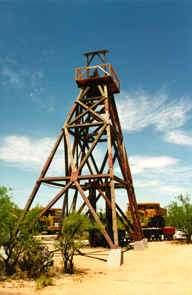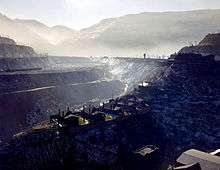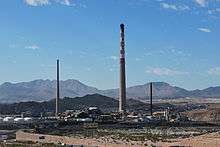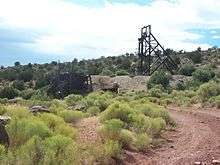Asarco


ASARCO LLC (American Smelting and Refining Company) is a mining, smelting, and refining company based in Tucson, Arizona, USA, that mines and processes primarily copper. The company is a subsidiary of Grupo México.
Its three largest open-pit mines are the Mission, Silver Bell and the Ray mines in Arizona. Its mines produce 350,000,000 to 400,000,000 pounds (159,000,000 to 181,000,000 kg) of copper a year. Asarco conducts solvent extraction and electrowinning at the Ray and Silver Bell mines in Pima County, Arizona and Pinal County, Arizona and a smelter in Hayden, Arizona. Before its smelting plant in El Paso, Texas was suspended in 1999, it was producing 1,000,000,000 pounds (454,000,000 kg) of anodes each year. Refining at the mines as well as at a copper refinery in Amarillo, Texas produce 375,000,000 pounds (170,000,000 kg) of refined copper each year.
Asarco's hourly workers are primarily represented by the United Steelworkers.
Asarco has 20 superfund sites across the United States, and it is subject to considerable litigation over pollution. In 2008 it made a settlement with the government of $1.79 billion for contamination at various sites; the funds were allotted to the Environmental Protection Agency (EPA) for cleanup at 26 sites around the country.[1]
History

ASARCO was founded in 1888 as the American Smelting and Refining Company by Henry H. Rogers, William Rockefeller, Adolph Lewisohn, Anton Eilers and Leonard Lewisohn. From 1901-1958, American Smelting and Refining was a member of the Dow Jones Industrial Average.
In 1901 Meyer Guggenheim and his sons took over the company.
On January 11, 1916, sixteen ASARCO employees were killed and mutilated by Pancho Villa's men near the town of Santa Isabel, Chihuahua. It was one of the incidents that sparked the Mexican Expedition, a United States Army attempt to capture or kill Villa.
Based in Tucson, Arizona, the company grew to conduct mining, smelting, and refining primarily copper. This metal required open-pit mining; the company's three largest such works are the Mission, Silver Bell and the Ray mines in Arizona. The company had also operated in silver mining in Idaho. Its mines produce 350,000,000 to 400,000,000 pounds (159,000,000 to 181,000,000 kg) of copper a year.
Asarco conducts solvent extraction and electrowinning at the Ray and Silver Bell mines in Pima County, Arizona and Pinal County, Arizona and a smelter in Hayden, Arizona. It also had a smelting plant in El Paso, Texas, which operations were suspended.
In 1975 it officially changed its name to Asarco Incorporated. In 1999 it was acquired by Grupo México, which had begun as Asarco's 49%-owned Mexican subsidiary in 1965.
On August 9, 2005, the company filed for Chapter 11 bankruptcy in Corpus Christi,[2] Texas under then-president Daniel Tellechea.
Pollution and environmental issues

ASARCO has been found responsible for environmental pollution at 20 Superfund sites across the U.S. by the Environmental Protection Agency. Those sites are:
- Interstate Lead Company, or ILCO, labeled EPA Site ALD041906173, and located in Leeds, Jefferson County, Alabama[3]
- Argo Smelter, Omaha & Grant Smelter, labeled EPA Site COD002259588, and located at Vasquez Boulevard and I-70 in Denver, Colorado[4]
- Smeltertown, a copper smelter used to illegally dispose of hazardous waste, in El Paso, El Paso County, Texas. The plant has since been dismantled.[5]
- California Gulch mine and river systems in Leadville, Colorado;
- Summitville Consolidated Mining Corp., Inc. (SCMCI), now bankrupt, EPA Site COD983778432, in Del Norte, Rio Grande County, Colorado;
- ASARCO Globe Plant, EPA Site COD007063530, Globeville, near South Platte River, Denver and Adams County, Colorado;
- Bunker Hill Mining and Metallurgical, Coeur d'Alene River Basin, Idaho;
- Kin-Buc Landfill in New Jersey;
- Tar Creek (Ottawa County) lead and zinc operations and surrounding residences in Oklahoma;
- Commencement Bay, Near Shore/Tide Flats smelter, groundwater, and residences in Tacoma and Ruston, Washington.
Litigation history

After the Colorado Department of Public Health and Environment sued ASARCO for damages to natural resources in 1983, the EPA placed the ASARCO Globe Plant on its National Priorities List of Superfund sites, with ASARCO to pay for the site's cleanup.[6]
In 1972 ASARCO's downtown Omaha plant in Nebraska was found to be releasing high amounts of lead into the air and ground surrounding the plant. In 1995 ASARCO submitted a demolition and site cleanup plan to the Nebraska Department of Environmental Quality for their impact on the local residential area. Fined $3.6 million in 1996 for discharging lead and other pollutants into the Missouri River, ASARCO closed its Omaha plant in July 1997.[7] After extensive site cleanup, the land was turned over to the City of Omaha as a 23-acre (93,000 m2) park. All of East Omaha, comprising more than 8,000 acres (32 km²), was declared a Superfund site. As of 2003, 290 acres (1.2 km²) had been cleaned.[8]
In 1991 the Coeur d'Alene Tribe filed suit under CERCLA against Hecla Mining Company, ASARCO and other defendants for damages and cleanup costs downstream of what has been designated as the Bunker Hill Mine and Smelting Complex Superfund site. Contamination had affected Lake Coeur d'Alene and the Saint Joe River, as well as related waters and lands, and cleanup had been under way since the early 1980s. In 1996 the United States joined the suit. In 2008 after emerging from bankruptcy, ASARCO LLC settled for $452 million for contributions to this site.[9][10] This was part of a nearly $2 billion settlement (see below) with the US for a total of 26 sites.[1]
In 2007, the Environmental Protection Agency released the results of soil and air tests in Hayden, Arizona taken adjacent to the ASARCO Hayden Smelter. The results showed abnormally high amounts of pollutants that violate prescribed health standards. Arsenic, lead and copper were among the most egregious pollutants found in Hayden. As a consequence of the contamination, the EPA proposed to add Hayden, Arizona to the list of Federal "Superfund" sites. This action would provide funding to clean up the contamination. ASARCO fought the action, supported by Democratic Gov. Janet Napolitano, who said: "I am asking that the EPA delay final decision on listing until March 31, 2008. This would provide ample time for the EPA, in close coordination with ADEQ, to enter an agreement with Asarco to conduct remedial actions..."[11] After emerging from Chapter 11 bankruptcy in 2008, ASARCO made a settlement with the government of $1.79 billion for contamination at various sites; the funds were allotted to the Environmental Protection Agency (EPA) for cleanup at 26 sites around the country.[1]
Documentary
ASARCO's Tar Creek Superfund site was the subject of the film documentary, Tar Creek (2009), made by Matt Myers. At one time, Tar Creek was considered to be the worst environmental problem on the EPA's list of more than 1200 sites.
See also
- List of Superfund sites in Alabama
- List of Superfund sites in Colorado
- List of Superfund sites in Illinois
- List of Superfund sites in Oklahoma
- Picher, Oklahoma
References
- 1 2 3 ICTMN Staff, "Mining Company to Pay Coeur d’Alene, State of Idaho and U.S. Government", Indian Country Today Media Network, 16 June 2011; accessed 2 June 2016
- ↑ "Newmont Mining, Form 10-Q, Quarterly Report, Filing Date Oct 28, 2005". secdatabase.com. Retrieved Jan 15, 2013.
- ↑ ILCO EPA. Retrieved 4/10/08.
- ↑ Argo Smelter, Omaha and Grant Smelter, EPA. Retrieved 4/10/08.
- ↑ El Paso Smelter Timeline, EPA. Retrieved 7/23/2012.
- ↑ Asarco Globe Plant, Colorado
- ↑ Early Omaha: Gateway to the West: "American Smelter and Refining Company" Archived September 27, 2007, at the Wayback Machine. Omaha Public Library. Retrieved 2/3/08.
- ↑ (2003) National Priorities List Site Narrative for Omaha Lead. United States EPA. Retrieved 2/3/08.
- ↑ Becky Kramer, "Hecla Mining Co. settles Superfund cleanup lawsuit", The Spokesman, 14 June 2011; accessed 31 May 2016
- ↑ "Hecla Mining Company to Pay $263 Million in Settlement to Resolve Idaho Superfund Site Litigation and Foster Cooperation", Press release, US Department of Justice, 13 June 2011; accessed 31 May 2016
- ↑ Arizona Department of Environmental Quality
External links
| Wikimedia Commons has media related to Asarco. |
- Official website
- profile in International Directory of Company Histories, Vol. 4. St. James Press, 1991 (via fundinguniverse.com)
- Grupo México history
- A Toxic Century: Mining Giant Asarco Must Clean Up Mess : NPR 2010
- Link to CNN transcript of the ASARCO El Paso Video 2008
- Marilyn Berlin Snell, "Going for Broke" Sierra Club Magazine, May/June 2006.
- Michael E. Ketterer, The ASARCO El Paso Smelter: A Source of Local Contamination of Soils in El Paso (Texas), Ciudad Juarez (Chihuahua, Mexico), and Anapra (New Mexico), 2006.
- Jake Bernstein, Clean up or Cover Up? "The Texas Observer", 2004.
- Corpus Christi's Refinery row
- Describes criminal conviction of an ASARCO supplier
- ASARCO Taylor Springs Illinois, Historical Society of Montgomery County Illinois